Crossed Wires
by Andrew Robb
Reprinted from "Crown Jewels of the Wire", March 1987, page 16
This article was sent to us by Jack Hayes, Pakenham, Ontario, and appeared in
HORIZON CANADA, The New Popular History of Canada magazine. It is being reprinted with
the permission of the Center for the Study of Teaching Canada/Le Centre d'Etudes
en Enseignement du Canada, Education Tower, 1070 Laval University, Ste-Foy,
Quebec G1K 7P4
Prospectors, trappers and other travelers in the wilderness of north-western
British Columbia still occasionally encounter the scattered remains of one of
the 19th century's most ambitious schemes. Rusty wire, broken insulators and
overgrown trails are the relics of a project that at one time captured the
imagination of much of the western world.
The Collins' Overland Telegraph
Project was as much a part of the technological history of the mid-19th century
as the silicon chip is of the later 20th. Born of the desire to conquer distance
and speed communication, the project used the high technology then available --
the electric telegraph.
The dream of linking cities and continents with strands
of telegraph wire was a passion of many of the leading engineers and businessmen
of the day. Cyrus Field, the American financier who was responsible for the
laying of the first successful Atlantic cable in July 1866, is well known. Perry
McDonough Collins, an entrepreneur and visionary of equal stature, has slipped
into relative obscurity. So, for that matter, has the contribution that Collins
and his work made to the early development of British Columbia.
|
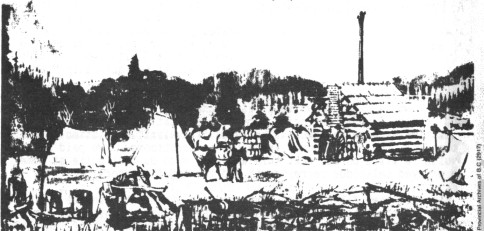
Telegraph station, Bulkley Valley, 1866. Today, when we
can pick up the
telephone and dial Moscow, it is hard to imagine a time when worldwide
communication took weeks, even months The Collins Overland Telegraph was an
attempt to speed up communication between North America and Russia by stringing
a line between San Francisco and Siberia. The painting is by J. C. White, an
artist attached to the construction party.
|
Samuel Morse's
invention of the electric telegraph in 1835 marked the start of a communications
revolution. After the first short line was completed in 1844 between Washington
and Baltimore, most of the settled parts of North America were soon linked by
telegraph wire.
In Europe there was a similar and rapid expansion. Morse Code, by the early 1860s, had become an international
language, and the telegraph had transformed conceptions of time and distance.
Newspapers now carried despatches 'by wire," bringing immediacy to events
that formerly were known days or weeks after the fact.
By the early 1860s, the
one remaining challenge to the telegraph engineers was the establishment of an
intercontinental link. Americans and Europeans, facing each other across the
broad but familiar Atlantic, thought first of a submarine cable. Since the mid-1850s, insulated submarine cables had linked England and the Continent, but the
Atlantic cable project seemed doomed to failure. Attempts had been made since
1857 to lay a cable, but had failed because of broken wire and the inability to
transmit over long distances on an underwater cable. Many were convinced that an
Atlantic cable would never work.
Perry Collins proposed an alternative. Why not
go west to Europe rather than east? North America and the Eurasian land mass
were separated by only the narrow waters of Bering Strait if one looked to the
northwest. To be sure, there were also thousands of kilometres of virtually
unexplored wilderness to be crossed, but this, though formidable, was not
insurmountable in either human or technological terms.
Scouting the Terrain
It was in many ways natural for Collins to think in
terms of a western route linking the continents. Born in New York in 1813, his
early adult years were spent as a law clerk in New Orleans and New York City.
Like thousands of other young men, he had followed the gold rush to California
in 1849. More suited to business than mining, he was soon a partner in a gold
brokerage firm and increasingly aware of the commercial possibilities of the
West.
|
A View of Canada Going to Pieces
Frederick Whymper, an English artist, joined the Collins' Overland Project as
an illustrator in 1866. He recounted his experiences in a book, Travel and
Adventure in the Territory of Alaska, published in London in 1868.
Commenting on
the United States' purchase of Alaska from Russia in 1867, he had this to say
about the significance of the move for the future of Canada:
"There are
many, both in England and America, who look on this purchase as the first move
towards an American occupation of the whole continent...
"We [Britain] shall
be released from an encumbrance, a source of expense and possible weakness; they
[the U.S.], freed from the trammels of periodical alarms of invasion, and
feeling strength of independence, will develop and grow; and speaking very
plainly and to the point - - our commercial relations with them will double and
quadruple in value... That it is the destiny of the U.S. to possess the whole
northern continent I do believe..."
|
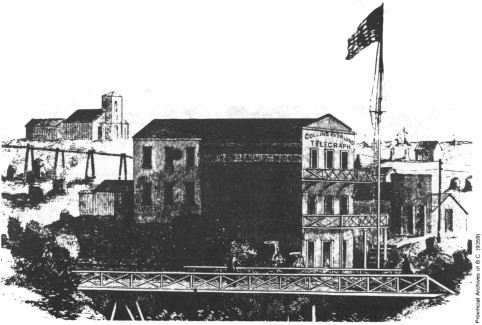
Terminal station. Before it was abandoned, the Collins line
stretched
from New Westminster (shown here) to the Skeena Valley in northern B.C. |
By the mid-1850s, Collins, together w ith entrepreneurs like Milton Latham and William Gwin, both later to become senators from California and
influential allies, had become convinced that the North Pacific and Asiatic
Russia were a rich potential field for American commerce. Collins had himself
appointed American "Commercial Agent for the Amur River" and visited
this frontier region of the Russian Empire, becoming increasingly convinced of
the commercial possibilities for the United States. His book, Voyage Down the
Amoor (1860) described in glowing terms the opportunities for American trade
and technology.
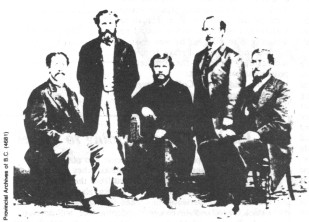
Man in charge. Edmund Conway (seated centre), a veteran of the American Civil
War, was placed in charge of construction through British Columbia. He traveled
on foot up the Fraser Valley from New Westminster to Hope laying out the route
of the southern section. Partly at Conway's urging, the government agreed to
build a wagon road from the coast to link up with the already completed Cariboo
Road in the interior. The telegraph could hove a right-of-way along the road and
would only have to bear the expense of erecting poles and stringing wire. |
The commercial potential of a telegraph linking Europe and
America via Bering Strait was also obvious to Collins. Whoever controlled the
huge volume of telegraph communications between the continents was assured
healthy profits. If such a line could also open Russian America, British
Columbia and Asia to American commerce. so much the better.
His first thought
was to promote a line from Montreal, across Hudson Bay Co. territory and through
Russian America to Bering Strait. This would be the shortest route and would
avoid the mountainous, difficult terrain of British Columbia. In Montreal,
Collins formed the Transmundane Telegraph Co., and began to look for support for
the scheme.
Despite the personal enthusiasm of backers such as Sir George
Simpson, overseas governor of the HBC, he had little success. Neither the
Canadian nor the British governments were interested in providing subsidies.
and the HBC would not contemplate the large capital outlay required. By 1860,
Collins was looking to the United States for support, convinced that the
Canadians would not move fast enough to seize the opportunity.
His timing was
good. In 1859 and 1860 the Western Union Telegraph Co., led by its dynamic
president, Hiram Sibley, was in the process of absorbing smaller rivals and
establishing a telegraph monopoly in the United States. It was also lobbying
Congress for support in building a transcontinental line to California, and saw Collins' scheme
as a
natural complement to its own.
'Living and Thinking Wire'
When the Western Union's wire reached San
Francisco in late 1861, Collins' plans were several thousand kilometres closer
to realization. The Civil War, which had shattered the union, made both the
urgency of an intercontinental link, and the difficulty of negotiating with
the British and Russians, more apparent. Collins spent the next two and a half
years negotiating with British, Russian and American officials to secure the necessary rights of way and support. By late 1864, his efforts succeeded,
and the Collins' Overland Telegraph Project was born.
Financed by a special
issue of Western Union shares, the project was of awesome proportions. A line
was to be built from San Francisco to Bering Strait where a short submarine
cable would be needed. From there, the line would be built south to the Russian
Pacific port of Nikolaevsk where it would connect with Russian lines.
Collins
received $100,000 for his negotiations and substantial amounts of stock in the
new company. As he told the Travellers' Club of New York in December 1865, the
future looked good for Western Union: ''Like the British Empire upon which the
sun never sets, our messages... will never cease; and those who can look sharply
into figures may be able to estimate the earnings of the Overland line." As
Senator Latham of California, an ardent supporter of Collins, put it: "We
hold the ball of the earth in our band, and wind upon it a network of living and
thinking wire.''
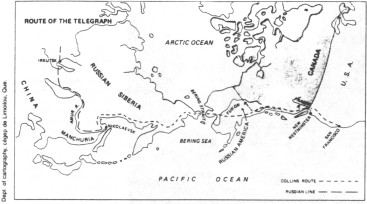
The Collins line.
Construction was divided into three sections: B.C., Russian
America (Alaska) and Siberia. Work in Siberia hardly got going before the project
shut down. |
The organization and operation of such a gigantic scheme
required the experience of military men. In late 1864, there was no shortage of
available talent. Col. Charles S. Bulkley, a veteran of the Military Telegraph
Corps, was the man chosen to head the project. Quickly, he recruited a staff
which included many who would later achieve considerable renown. Edmund Conway, another Telegraph
Corps veteran, was in charge of the British Columbia work. Others, such as
George Kennan. Franklin Pope and W. H. Dall would make valuable contributions to
the American knowledge of Alaska and Asiatic Russia.
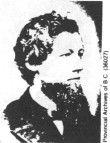
Charles Bulkley.
He was in charge of the entire project. |
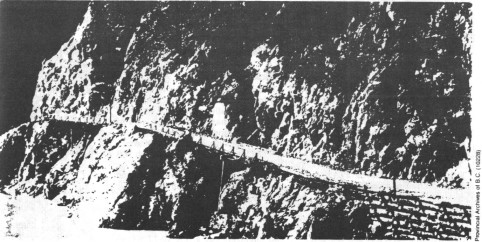
Cariboo Road. Wherever possible, the Collins line followed the Cariboo Road,
constructed in the early 1860s to give access to the goldfields of the interior. |
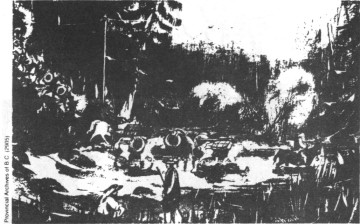 |
Stringing the
line. Two more views of telegraph construction by J.C. White.
Bottom, lines crossing a lake to one of the stations which were built every 40
km. Top, a pack train bringing in wire and other supplies. Whenever possible,
the company hired Indian and Chinese labourers who accepted the low wage of $15
a month. White colonists resented this policy, but the company persisted.
Conditions were hard and the rough colony was not to everyone's liking. Edmund
Conway complained that "one encounters nothing but heavy timber, rum mills,
broken miners, English aristocrats, loafers and swindlers... Banishment in
Siberia "is a paradise in comparison to this place." |
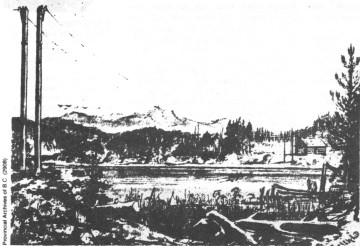 |
|
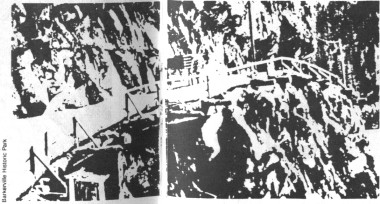
Road to Russia.
Another view of the Cariboo Road, which the telegraph line
followed up the Fraser Canyon. |
The project was organized along
military lines, and even had a naval branch to transport supplies to the widely
scattered survey and building parties. Three construction divisions were
established -- Siberia, Russian America and British Columbia -- each with their
own commanders, surveyors and labourers.
Quick Work
Except in southern British
Columbia, the line would pass through territory seen only by the Native people
and a few fur traders. The natural obstacles were of mammoth proportions.
Despite this, the project made surprisingly rapid progress.
By March 1865, New
Westminster was connected and work was begun on stretching wire up the Fraser
Valley and through the difficult terrain of the Fraser canyon. That year, the
line was completed to a point about 30 km north of Quesnel, when winter brought
work to a halt.
Surveyors, axemen, Chinese labourers and engineers cut a line
10-12 metres wide, along which poles were placed every 20 metres. At regular intervals,
cabins were built for supplies and telegraph equipment. In both Siberia and
Russian-America, the survey had proceeded quickly in 1865. When work began early
the following spring, the experienced crews made rapid progress. By July 1866,
the entire line had been surveyed, and the necessary supplies put in place.
In
B.C., the line had been completed to the Skeena Valley, and crews were pushing
north quickly. Even Victoria saw a small measure of its insularity ended as a
line reached the island city in April. It seemed as if the project could not be
stopped, so rapid was the progress.
Then, to spoil the mid-summer euphoria, came
potentially bad news. An Atlantic cable had been laid, and was working.
Taking a
nervous 'wait-and-see' attitude, the company halted construction work in B.C.,
but in the more remote regions of Russian-America and Siberia. work continued.
Atlantic cables had failed before, surely this one would too. By early 1867
though, the cable was still working. The end had come for the Overland Telegraph
Project.
Not a Total Loss
Work crews hung black crepe on telegraph poles in mourning.
Some equipment was loaded on company ships and returned to San Francisco, but
much more equipment was simply abandoned or sold to the Natives. For years
afterward, travelers reported Alaskan Natives awkwardly drinking tea out of
green glass insulators.
Although much was lost with the collapse of the project,
much also had been gained, especially in B.C. External communications had been
vastly improved and a connection made with the outside world. It would be
another 20 years before an all-Canadian telegraph line reached the Pacific.
British Columbia would get news of Canadian Confederation via an American wire
service.
Both Western Union and Collins continued to prosper despite this
setback. Collins lived comfortably in San Francisco and New York until his death
in 1900 at the age of 87. When, in 1867, American Secretary of State William
Seward arranged the purchase of Alaska, he was grateful to the scientists of the
telegraph project for their enthusiastic endorsement of his bargain with the
Russians. Thanks to the Collins project, they were part of a tiny group of
Americans who were fully aware of the richness of Alaska's resources.
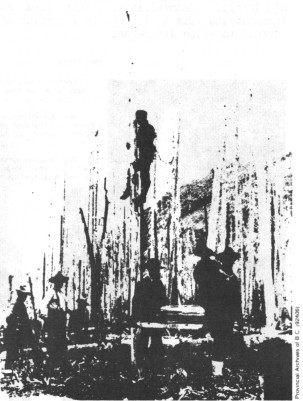
Yukon telegraph.
This line was the heir of the Collins project. The Yukon line was constructed in 1899 across the Yukon territory, and two years
later it was extended south to Quesnel in central British Columbia. Construction
techniques did not differ much from those employed on the Collins line. Wire was
strung on poles cut for the purpose, or on living trees topped and trimmed where
they grew. The wire was carried up the pole and tied to a glass or porcelain
insulator. Insulators prevented loss of electrical current if wire touched the
pole. |
|
